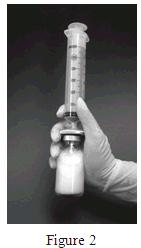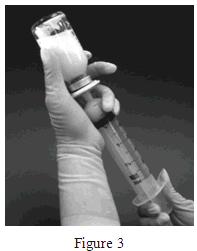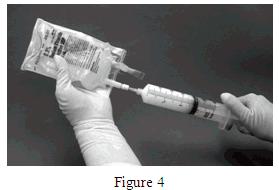|
米伐木肽注射剂(mifamurtide,L-MTP-PE,:Mepact)-全球第一个改善骨肉瘤长期存活的新药
Blood and lymphatic system disorders Anaemia has very commonly been reported when mifamurtide is used in conjunction with chemotherapeutic agents. In a randomised controlled study, the incidence of myeloid malignancy (acute myeloid leukaemia/myelodysplastic syndrome) was the same in patients receiving MEPACT plus chemotherapy as in patients receiving only chemotherapy (2.1%). Metabolism and nutritional disorders Anorexia (21%) was very commonly reported in phase I and II studies of mifamurtide Nervous system disorders Consistent with other generalised symptoms, the very common nervous system disorders were headache (50%) and dizziness (17%). One patient in the phase III study experienced 2 episodes of Grade 4 seizure while on study therapy with chemotherapy and mifamurtide. The second episode involved multiple grand mal seizures over the course of days. Mifamurtide treatment was continued for the remainder of the study without seizure recurrence. Ear and labyrinth disorders Although hearing loss may be attributable to ototoxic chemotherapy, like cisplatin, it is unclear whether MEPACT in conjunction with multi-agent chemotherapy may increase hearing loss. A higher percentage of objective and subjective hearing loss was observed overall in patients who received MEPACT and chemotherapy (12 % and 4%, respectively) in the phase III study (see Section 5.1 for a description of the study) compared to those patients that received only chemotherapy (7% and 1%). All patients received a total dose of cisplatin of 480 mg/m2 as part of their induction (neoadjuvant) and/or maintenance (adjuvant) chemotherapy regimen. Cardiac and vascular disorders Mild-moderate tachycardia (50%), hypertension (26%) and hypotension (29%) were very commonly reported in uncontrolled studies of mifamurtide. One serious incident of subacute thrombosis was reported in early studies, but no serious cardiac events were associated with mifamurtide in a large randomised controlled study (see section 4.4). Respiratory disorders Respiratory disorders, including dyspnoea (21%), cough (18%) and tachypnoea (13%) were very commonly reported, and two patients with pre-existing asthma developed mild to moderate respiratory distress associated with MEPACT treatment in a phase II study. Gastrointestinal disorders Gastrointestinal disorders were frequently associated with mifamurtide administration, including nausea (57%) and vomiting (44%) in about half of patients, constipation (17%), diarrhoea (13%) and abdominal pain (see section 4.4). Skin and subcutaneous disorders Hyperhidrosis (11%) was very common in patients receiving mifamurtide in uncontrolled studies. Musculoskeletal and connective tissue disorders Low grade pain was very common in patients receiving mifamurtide, including myalgia (31%), back pain (15%), extremity pain (12%) and arthralgia (10%). General disorders and administration site conditions The majority of patients experience chills (89%), fever (85%) and fatigue (53%). These are typically mild to moderate, transient in nature and generally respond to palliative treatment (e.g., paracetamol for fever). Other generalised symptoms that were typically mild to moderate and very common included hypothermia (23%), malaise (13%), pain (15%), asthenia (13%) and chest pain (11%). Oedema, chest discomfort, local infusion or catheter site reactions and 'feeling cold' were less frequently reported in these patients, mostly with late stage malignant disease. Investigations An osteosarcoma patient in a phase II study who had high creatinine level at enrolment showed an increase in blood urea and blood creatinine which was associated with mifamurtide use. Immune system disorders In a phase I study, there was one report of severe allergic reaction occurring after the first infusion of mifamurtide at 6 mg/m2 dose level. The patient experienced shaking, chills, fever, nausea, vomiting, uncontrollable coughing, shortness of breath, cyanotic lips, dizziness, weakness, hypotension, tachycardia, hypertension and hypothermia leading to study discontinuation. There was also one report of a grade 4 allergic reaction (hypertension) requiring hospitalization in the phase III study (see section 4.4). Reporting of suspected adverse reactions Reporting suspected adverse reactions after authorisation of the medicinal product is important. It allows continued monitoring of the benefit/risk balance of the medicinal product. Healthcare professionals are asked to report any suspected adverse reactions via the Yellow Card Scheme at: www.mhra.gov.uk/yellowcard. 4.9 Overdose No case of overdose has been reported within the approved indication. The maximum tolerated dose in phase I studies was 4-6 mg/m2 with a high variability of adverse reactions. Signs and symptoms that were associated with higher doses and/or were dose limiting were not life-threatening, and included fever, chills, fatigue, nausea, vomiting, headache and hypo- or hypertension. A healthy adult volunteer accidentally received a single dose of 6.96 mg mifamurtide and experienced a reversible treatment-related event of orthostatic hypotension. In the event of an overdose, it is recommended that appropriate supportive treatment be initiated. Supportive measures should be based on institutional guidelines and the clinical symptoms observed. Examples include paracetamol for fever, chills and headache and anti-emetics (other than steroids) for nausea and vomiting. 5. Pharmacological properties 5.1 Pharmacodynamic properties Pharmacotherapeutic group: Immunostimulants, Other immunostimulants, ATC code: L03AX15 Mechanism of action Mifamurtide (muramyl tripeptide phosphatidyl ethanolamine, MTP-PE) is a fully synthetic derivative of muramyl dipeptide (MDP), the smallest naturally-occurring immune stimulatory component of cell walls from Mycobacterium sp. It has similar immunostimulatory effects as natural MDP with the additional advantage of a longer half-life in plasma. MEPACT is a liposomal formulation specifically designed for in vivo targeting to macrophages by intravenous infusion. MTP-PE is a specific ligand of NOD2, a receptor found primarily on monocytes, dendritic cells and macrophages. MTP-PE is a potent activator of monocytes and macrophages. Activation of human macrophages by mifamurtide is associated with production of cytokines, including tumour necrosis factor (TNF-α), interleukin-1 (IL-1β), IL-6, IL-8, and IL-12 and adhesion molecules, including lymphocyte function-associated antigen-1 (LFA-1) and intercellular adhesion molecule-1 (ICAM-1). In vitro-treated human monocytes killed allogeneic and autologous tumour cells (including melanoma, ovarian, colon, and renal carcinoma), but had no toxicity towards normal cells. In vivo administration of mifamurtide resulted in the inhibition of tumour growth in mouse and rat models of lung metastasis, skin and liver cancer, and fibrosarcoma. Significant enhancement of disease-free survival was also demonstrated in the treatment of dog osteosarcoma and hemangiosarcoma with mifamurtide as adjuvant therapy. The exact mechanism by which mifamurtide activation of monocytes and macrophages leads to antitumour activity in animals and humans is not yet known. Clinical safety and efficacy The safety of liposomal mifamurtide has been assessed in more than 700 patients with various kinds and stages of cancer and in 21 healthy adult subjects (see section 4.8). Mifamurtide significantly increased the overall survival of patients with newly-diagnosed resectable high-grade osteosarcoma when used in conjunction with combination chemotherapy when compared to chemotherapy alone. In a randomised phase III study of 678 patients (age range from 1.4 to 30.6 years) with newly-diagnosed resectable high-grade osteosarcoma, the addition of adjuvant mifamurtide to chemotherapy either doxorubicin cisplatin and methotrexate with or without ifosfamide, resulted in a relative reduction in the risk of death of 28% (p = 0.0313, hazard ratio (HR) = 0.72 [95% confidence interval (CI): 0.53, 0. 97]). 5.2 Pharmacokinetic properties The pharmacokinetics of mifamurtide have been characterized in healthy adult subjects following a 4 mg intravenous infusion and in paediatric and adult patients with osteosarcoma following a 2 mg/m2 intravenous infusion. In 21 healthy adult subjects mifamurtide was cleared rapidly from serum (minutes) with a half-life of 2.05 ± 0.40 hours, resulting in a very low serum concentration of total (liposomal and free) mifamurtide. The mean AUC was 17.0 ± 4.86 h x nM and Cmax was 15.7 ± 3.72 nM. In 28 osteosarcoma patients aged 6 to 39 years serum total (liposomal and free) mifamurtide concentrations declined rapidly with a mean half-life of 2.04 ± 0.456 hours. BSA-normalized clearance and half-life were similar across the age range and consistent with that determined in healthy adult subjects, supporting the recommended dose of 2 mg/m2. In a separate study in 14 patients, mean serum concentration-time curves of total and free mifamurtide that were assessed after the first infusion of mifamurtide and after a last infusion 11 or 12 weeks later, were almost superimposable and the mean AUC values of the free mifamurtide after the first and last infusion were similar. These data indicate that neither total nor free mifamurtide accumulated during the treatment period. At 6 hours after injection of radiolabelled liposomes containing 1 mg mifamurtide, radioactivity was found in liver, spleen, nasopharynx, thyroid, and, to a lesser extent, in lung. The liposomes were phagocytosed by cells of the reticuloendothelial system. In 2 of 4 patients with lung metastases, radioactivity was associated with lung metastases. Metabolism of liposomal MTP-PE has not been studied in humans. After injection of radiolabelled liposomes containing mifamurtide, mean half-life of radiolabelled material was biphasic with an α-phase of about 15 minutes and a terminal half-life of approximately 18 hours. Special populations Renal impairment The pharmacokinetics of a single 4mg dose of mifamurtide following a 1 hour intravenous infusion were evaluated in adult volunteers with mild (n=9) or moderate (n=8) renal impairment and in age- , sex-, and weight-matched healthy adults with normal renal function (n=16). There was no effect of mild (50 mL/min ≤ CLcr ≤80 mL/min) or moderate (30 mL/min ≤ CLcr < 50 mL/min) renal insufficiency on the clearance of total MTP-PE, when compared with that observed in healthy adult subjects with normal renal function (CLcr > 80 mL/min). Additionally, the systemic exposures (AUCinf) of free (non-liposome associated) MTP-PE in mild or moderate renal insufficiency were similar to those observed in healthy adult subjects with normal renal function. Hepatic impairment The pharmacokinetics of a single 4 mg dose of mifamurtide following a 1 hour intravenous infusion were evaluated in adult volunteers with mild (Child-Pugh class A; n=9) or moderate (Child-Pugh class B; n=8) hepatic impairment and in age- ,sex-, and weight-matched healthy adults with normal hepatic function (n=19). There was no effect of mild hepatic impairment on the systemic exposure (AUCinf) of total MTP-PE. Moderate hepatic impairment resulted in a small increase in AUCinf of total MTP-PE, with the geometric least square mean ratio (expressed as %) for moderate hepatic impairment in reference to the matched normal hepatic function group being 119% (90% CI: 94.1%-151%). Pharmacokinetic variability was higher in the moderate hepatic impairment group (co-efficient of variation in systemic exposure [AUCinf] was 50% versus <30% in the other hepatic function groups). Mean half-lives of total and free MTP-PE in mild hepatic impairment were 2.02 hours and 1.99 hours, respectively, and were comparable to those in subjects with normal hepatic function (2.15 hours and 2.26 hours, respectively). Mean half-lives of total and free MTP-PE in moderate hepatic impairment were 3.21 hours and 3.15 hours, respectively. Additionally, the geometric mean plasma AUCinf of free (non-liposome associated) MTP-PE in mild and moderate hepatic impairment were 47% higher than the corresponding values in the matched normal hepatic function groups. These changes were not considered to be clinically meaningful as the maximum tolerated dose (4-6 mg/m2) of mifamurtide is 2-3 times the recommended dose (2 mg/m2). 5.3 Preclinical safety data In sensitive species (rabbit and dog) the highest daily dose of liposomal mifamurtide that did not cause adverse effects was 0.1 mg/kg, corresponding to 1.2 and 2 mg/m2, respectively. The no-adverse-effect level for mifamurtide in animals corresponds roughly to the 2 mg/m2 recommend dose for humans. Data from a six month dog study of daily intravenous injections of up to 0.5 mg/kg (10 mg/m2) mifamurtide provide an 8- to 19-fold cumulative exposure safety margin for overt toxicity for the intended clinical dose in humans. Major toxic effects associated with these high daily and cumulative doses of mifamurtide were mainly exaggerated pharmacological effects: pyrexia, signs of pronounced inflammatory response manifested as synovitis, bronchopneumonia, pericarditis and inflammatory necrosis of the liver and bone marrow. The following events were also observed: haemorrhage and prolongation of coagulation times, infarcts, morphological changes in the wall of small arteries, oedema and congestion of the central nervous system, minor cardiac effects, and slight hyponatraemia. Mifamurtide was not mutagenic and did not cause teratogenic effects in rats and rabbits. Embryotoxic effects were observed only at maternal toxic levels. There were no results from general toxicity studies that suggested harmful effects on male or female reproductive organs. Specific studies addressing reproductive function, perinatal toxicity and carcinogenic potential have not been performed. 6. Pharmaceutical particulars 6.1 List of excipients 1-Palmitoyl-2-oleoyl-sn-glycero-3-phosphocholine (POPC) 1,2-Dioleoyl-sn-glycero-3-phospho-L-serine monosodium salt (OOPS) 6.2 Incompatibilities This medicinal product must not be mixed with other medicinal products except those mentioned in section 6.6. 6.3 Shelf life Unopened vial of powder: 30 months Reconstituted suspension: Chemical and physical stability has been demonstrated for 6 hours up to 25°C. From a microbiological point of view, immediate use is recommended. If not used immediately, the reconstituted, filtered and diluted solution in-use storage times and conditions prior to use of the reconstituted product are the responsibility of the user and must not be longer than 6 hours at 25°C. Do not refrigerate or freeze the solution. 6.4 Special precautions for storage Store in a refrigerator (2°C – 8°C). Do not freeze. Keep the vial in the outer carton in order to protect from light. For storage conditions of the reconstituted medicinal product, see section 6.3. 6.5 Nature and contents of container 50 ml type I glass vial with a grey butyl rubber stopper, aluminium seal and plastic flip-off cap, containing 4 mg of mifamurtide. Each carton contains one vial and one single-use, non-pyrogenic, sterile filter for MEPACT supplied in a PVC-grade blister. 6.6 Special precautions for disposal and other handling MEPACT must be reconstituted, filtered using the filter provided and further diluted using aseptic technique. Each vial should be reconstituted with 50 ml of sodium chloride 9 mg/ml (0.9 %) solution for injection. After reconstitution, each ml suspension in the vial contains 0.08 mg mifamurtide. The volume of reconstituted suspension corresponding to the calculated dose is extracted through the filter provided and further diluted with additional 50 ml sodium chloride 9 mg/ml (0.9 %) solution for injection according to the detailed instructions shown below. Instructions for preparation of MEPACT for intravenous infusion Materials provided in each package - • MEPACT powder for concentrate for dispersion for infusion (vial) • Filter for MEPACT Materials required but not provided - • Sodium chloride 9 mg/ml (0.9%) solution for injection, 100 ml bag • One single use 60 or 100 ml sterile syringe with luer lock • Two medium (18) gauge sterile injection needles It is recommended that the reconstitution of the liposomal suspension should be performed in a laminar flow cabinet utilising sterile gloves using aseptic technique. The lyophilised powder should be allowed to reach a temperature between approximately 20°C – 25°C prior to reconstitution, filtering using the filter provided and dilution. This should take approximately 30 minutes. 1. The cap of the vial should be removed and the stopper cleaned using an alcohol pad. 2. The filter should be removed from the blister pack, and the cap removed from the filter spike. The spike should then be inserted into the vial septum firmly until seated. The filter luer connector cap should not be removed at this time. 3. The 100 ml sodium chloride 9 mg/ml (0.9%) solution for injection bag, needle and syringe should be unpacked (not provided in the pack). 4. The site of the sodium chloride 9 mg/ml (0.9%) solution for injection bag where the needle is going to be inserted should be swabbed with an alcohol pad. 5. Using the needle and syringe, 50 ml of sodium chloride 9 mg/ml (0.9%) solution for injection should be withdrawn from the bag. 6. After removing the needle from the syringe, the syringe should be attached to the filter by opening the filter luer connector cap (Figure 1). 7. The sodium chloride 9 mg/ml (0.9%) solution for injection is added to the vial by slow, firm depression of the syringe plunger. The filter and syringe must not be removed from the vial. 10. The desired dose may be withdrawn from the vial by inverting the vial and slowly pulling back on the syringe plunger (Figure 3). Each ml reconstituted suspension contains 0.08 mg mifamurtide. The volume of suspension to be withdrawn for dose quantities is calculated as follows:
11. The syringe should then be removed from the filter and a new needle placed on the suspension-filled syringe. The bag injection site should be wiped with an alcohol pad and the suspension in the syringe should be injected into the original bag containing the remaining 50 ml of sodium chloride 9 mg/ml (0.9%) solution for injection (Figure 4).
法国上市厂家:IDM制药公司(IDM Pharma S.A.)
| ||||||||||||||||||||||||||||||||||||||||||||||||||||||||||||||||||||||||||||||||||||||||||||||||||||||||||||||||








